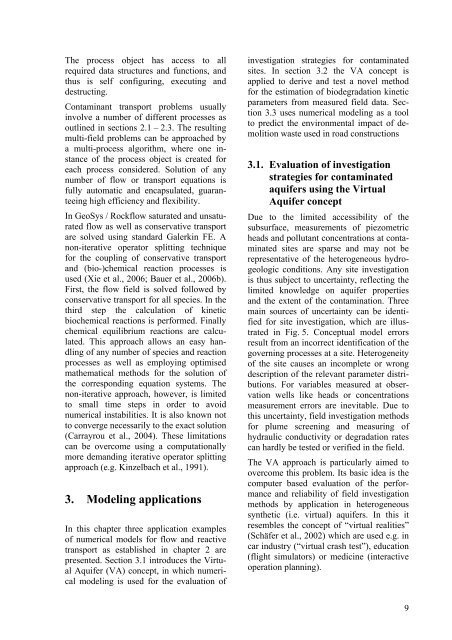Applied numerical modeling of saturated / unsaturated flow and ...
Applied numerical modeling of saturated / unsaturated flow and ...
Applied numerical modeling of saturated / unsaturated flow and ...
Create successful ePaper yourself
Turn your PDF publications into a flip-book with our unique Google optimized e-Paper software.
The process object has access to all<br />
required data structures <strong>and</strong> functions, <strong>and</strong><br />
thus is self configuring, executing <strong>and</strong><br />
destructing.<br />
Contaminant transport problems usually<br />
involve a number <strong>of</strong> different processes as<br />
outlined in sections 2.1 – 2.3. The resulting<br />
multi-field problems can be approached by<br />
a multi-process algorithm, where one instance<br />
<strong>of</strong> the process object is created for<br />
each process considered. Solution <strong>of</strong> any<br />
number <strong>of</strong> <strong>flow</strong> or transport equations is<br />
fully automatic <strong>and</strong> encapsulated, guaranteeing<br />
high efficiency <strong>and</strong> flexibility.<br />
In GeoSys / Rock<strong>flow</strong> <strong>saturated</strong> <strong>and</strong> un<strong>saturated</strong><br />
<strong>flow</strong> as well as conservative transport<br />
are solved using st<strong>and</strong>ard Galerkin FE. A<br />
non-iterative operator splitting technique<br />
for the coupling <strong>of</strong> conservative transport<br />
<strong>and</strong> (bio-)chemical reaction processes is<br />
used (Xie et al., 2006; Bauer et al., 2006b).<br />
First, the <strong>flow</strong> field is solved followed by<br />
conservative transport for all species. In the<br />
third step the calculation <strong>of</strong> kinetic<br />
biochemical reactions is performed. Finally<br />
chemical equilibrium reactions are calculated.<br />
This approach allows an easy h<strong>and</strong>ling<br />
<strong>of</strong> any number <strong>of</strong> species <strong>and</strong> reaction<br />
processes as well as employing optimised<br />
mathematical methods for the solution <strong>of</strong><br />
the corresponding equation systems. The<br />
non-iterative approach, however, is limited<br />
to small time steps in order to avoid<br />
<strong>numerical</strong> instabilities. It is also known not<br />
to converge necessarily to the exact solution<br />
(Carrayrou et al., 2004). These limitations<br />
can be overcome using a computationally<br />
more dem<strong>and</strong>ing iterative operator splitting<br />
approach (e.g. Kinzelbach et al., 1991).<br />
3. Modeling applications<br />
In this chapter three application examples<br />
<strong>of</strong> <strong>numerical</strong> models for <strong>flow</strong> <strong>and</strong> reactive<br />
transport as established in chapter 2 are<br />
presented. Section 3.1 introduces the Virtual<br />
Aquifer (VA) concept, in which <strong>numerical</strong><br />
<strong>modeling</strong> is used for the evaluation <strong>of</strong><br />
investigation strategies for contaminated<br />
sites. In section 3.2 the VA concept is<br />
applied to derive <strong>and</strong> test a novel method<br />
for the estimation <strong>of</strong> biodegradation kinetic<br />
parameters from measured field data. Section<br />
3.3 uses <strong>numerical</strong> <strong>modeling</strong> as a tool<br />
to predict the environmental impact <strong>of</strong> demolition<br />
waste used in road constructions<br />
3.1. Evaluation <strong>of</strong> investigation<br />
strategies for contaminated<br />
aquifers using the Virtual<br />
Aquifer concept<br />
Due to the limited accessibility <strong>of</strong> the<br />
subsurface, measurements <strong>of</strong> piezometric<br />
heads <strong>and</strong> pollutant concentrations at contaminated<br />
sites are sparse <strong>and</strong> may not be<br />
representative <strong>of</strong> the heterogeneous hydrogeologic<br />
conditions. Any site investigation<br />
is thus subject to uncertainty, reflecting the<br />
limited knowledge on aquifer properties<br />
<strong>and</strong> the extent <strong>of</strong> the contamination. Three<br />
main sources <strong>of</strong> uncertainty can be identified<br />
for site investigation, which are illustrated<br />
in Fig. 5. Conceptual model errors<br />
result from an incorrect identification <strong>of</strong> the<br />
governing processes at a site. Heterogeneity<br />
<strong>of</strong> the site causes an incomplete or wrong<br />
description <strong>of</strong> the relevant parameter distributions.<br />
For variables measured at observation<br />
wells like heads or concentrations<br />
measurement errors are inevitable. Due to<br />
this uncertainty, field investigation methods<br />
for plume screening <strong>and</strong> measuring <strong>of</strong><br />
hydraulic conductivity or degradation rates<br />
can hardly be tested or verified in the field.<br />
The VA approach is particularly aimed to<br />
overcome this problem. Its basic idea is the<br />
computer based evaluation <strong>of</strong> the performance<br />
<strong>and</strong> reliability <strong>of</strong> field investigation<br />
methods by application in heterogeneous<br />
synthetic (i.e. virtual) aquifers. In this it<br />
resembles the concept <strong>of</strong> “virtual realities”<br />
(Schäfer et al., 2002) which are used e.g. in<br />
car industry (“virtual crash test”), education<br />
(flight simulators) or medicine (interactive<br />
operation planning).<br />
9

















